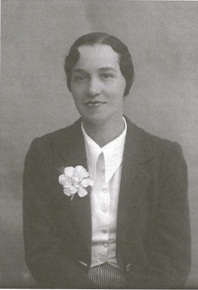Celebrating the long career of a seasoned stage and film performer
 |
| Emma Gramatica came from an acting background in the early 20th century |
Emma appeared in 29 films between 1919 and 1962 and was also a principal actress in the Italian theatre in the late 19th and early 20th centuries. Her sisters, Irma and Anna Gramatica, were also actresses. Anna, married the actor Ruggero Capodaglio and therefore became the sister-in-law of the famous actress, Wanda Capodaglio.
While still a teenager, Emma Gramatica made her stage debut next to the celebrated actress Eleonora Duse in La Gioconda by Gabriele D’Annunzio.
Emma became the primattrice (first actress) in the stage companies led by some of the most prestigious names in the Italian theatre of the late 19th and early 20th centuries, such as Ermete Zacconi, Flavio Andò, Enrico Reinach, and Ermete Novelli.
In the early part of the 20th century, she formed the famous theatre company Gramatica-Carini-Piperno, employing leading performers such as Renzo Ricci and Lola Braccini.
Emma’s film debut came - in the silent era - in 1916 when she appeared as a marriage wrecker in Quando il canto si spegne (When the Song is Over) opposite Luigi Serventi. The press praised her for her stage qualities but criticised her looks and theatricality and said they couldn’t accept her in the part of a mistress for whom a man would break up his marriage.
As a result, Emma was to stay away from films until the arrival of sound cinema in Italy.
In 1931, by which time she was 57, she appeared in the film La Vecchia Signora, playing the part of an impoverished old lady selling chestnuts in the streets to support her niece.
 |
| As an older actress, Gramatica was able to earn extra cash |
Emma Gramatica was in her seventies when she achieved her most important film and television successes.
Her most famous film was Miracolo a Milano, a neorealist fable directed by Vittorio De Sica in 1951, when she played the part of old Lolotta, who finds a baby among the cauliflowers in her garden and names him Totò, the movie’s central character played by Francesco Golisano. She brings him up to be both optimistic and kind.
Emma also appeared in Don Camillo: Monsignor in 1961 starring Fernandel and Gino Cervi.
The Don Camillo stories, featuring the characters Don Camillo and Peppone - the parish priest and Communist mayor of a fictional town in rural post-World War Two Italy - were the creation of writer and journalist Giovannino Guareschi in the 1940s and 1950s. They were hugely popular and have been adapted many times for film, radio and TV.
Emma received many awards and honours in Italy during her career and the Legion of Honour in France. The sculptor Mario Rutelli celebrated Emma’s looks in 1905 by creating a bronze portrait bust of her.
The actress died in Ostia, a town near the ancient port of Rome, at the age of 91 in 1965. She was laid to rest in her family tomb in the cemetery of Signa in Via Sorelle Gramatica in Florence, with her sister, Irma, and her parents.
 |
| Fidenza's Piazza Garibaldi is flanked by the Palazzo Comunale, the town hall |
Travel tip:
Fidenza, where Emma Gramatica was born, is an historic town of 27,000 inhabitants in the Emilia-Romagna region of northern Italy, about 30km (19 miles) northwest of Parma and 45km (28 miles) southeast of Piacenza along the ancient Via Emilia. Originally known as Fidentia during Roman times, the town was later called Borgo San Donnino, in honour of Saint Domninus, a Christian martyr. It was renamed Fidenza in 1927. The town’s attractions include a 12th–13th century Romanesque cathedral, dedicated to St Domninus, with a façade attributed to the sculptor Benedetto Antelami. The town’s central square, Piazza Garibaldi, flanked by the Palazzo Comunale (Town Hall), is a lively civic space. Fidenza is close to Busseto - the birthplace of Verdi - the spa town of Salsomaggiore Terme, and the fortified village of Fontanellato. Fidenza had prominence in medieval times as a key stop along the Via Francigena, the pilgrimage route connecting Canterbury to Rome.
.jpg) |
| A street in the well preserved Roman resort of Ostia, near Rome |
Ostia - Lido di Ostia, to give its full name - is a seaside escape popular with Romans, offering long stretches of sandy beaches, vibrant nightlife, and seafood restaurants. It is situated on the Tyrrhenian coast just 30km (18 miles) southwest of the capital and easily accessible by train from central Rome. It blends beach culture with history, thanks to its proximity to the ancient Roman city of Ostia Antica. Highlights include the scenic pier Pontile di Ostia and Borghetto dei Pescatori, a quaint fishing village that forms part of the resort. Ostia Antica, founded in the 4th century BC, was the bustling port of ancient Rome. The remains offer a remarkably preserved glimpse into Roman urban life. The city was a hub for trade, grain storage, and maritime defense, reflecting Rome’s imperial might. Among the best preserved buildings are a Roman theatre, still used for performances today, a Forum and Baths and some apartment buildings that are rare examples of multi-story Roman housing. Ostia Antica has the advantage for visitors of being quieter and less crowded, for example, than the world famous ruins at Pompeii, but is an equally important site.
More reading:
Why Eleonora Duse is regarded as one of the greatest acting talents of all time
Vittorio De Sica and the golden age of neorealism in Italian cinema
Gino Cervi - from Don Camillo to Maigret
Also on this day:
1647: The death of scientist Evangelista Torricelli
1815: The birth of virtuoso violinist Camillo Sivori
1902: The birth of Carlo Gnocchi, chaplain to Italy’s WW2 alpine troops





.jpg)




.jpg)






_07.jpg)




.jpg)

.jpg)

.djvu.jpg)



.jpg)

_-_Facade.jpg)
